
Atrytonopsis is a genus of butterflies in the skipper family, Hesperiidae. They are native to Mexico and the southwestern United States.

Burnsius oileus, the tropical checkered skipper, is a species of skipper. It is found in the United States, south through the West Indies, Mexico and Central America to Costa Rica. It was transferred to genus Burnsius in 2019, and was previously known as Pyrgus oileus.

The crystal skipper is a species of butterfly in the family Hesperiidae that is found only along a 30-mile (50 km) stretch of barrier islands in North Carolina. The skipper was first discovered in 1978 and the paper describing it as a full species was published in 2015.
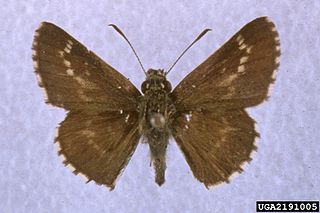
Amblyscirtes aesculapius is a butterfly of the family Hesperiidae. It is found from eastern Oklahoma and eastern Texas, east to south-east Virginia, south along the Atlantic Coast to northern Florida.

Amblyscirtes alternata is a butterfly of the family Hesperiidae. It is found from south-eastern Virginia south to Florida, west to east Texas.

Amblyscirtes hegon, the pepper-and-salt skipper, is a butterfly of the family Hesperiidae. It is found from Nova Scotia and Maine, west to southern Manitoba, south to Georgia, northern Florida and south-eastern Texas. It is mostly absent from the coastal plain.

Amblyscirtes vialis is a butterfly of the family Hesperiidae. It is found from British Columbia east across southern Canada to Maine and Nova Scotia, south to central California, northern New Mexico, Texas, the Gulf states and northern Florida.
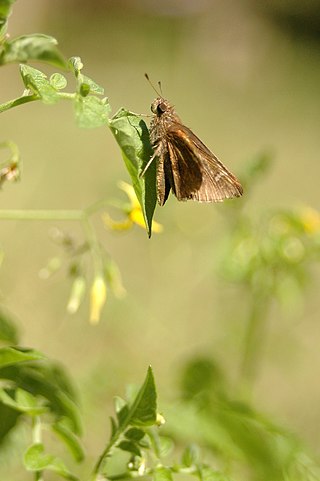
Lerema accius, the clouded skipper, is a butterfly of the family Hesperiidae. It is found in the United States from Georgia west to Texas, south to Florida, and south through Mexico and Central America to Venezuela and Colombia.

Lerodea eufala, the Eufala skipper or rice leaffolder, is a species of butterfly in the family Hesperiidae. It is found from the coast of Georgia, south through Florida and west across the southern United States to southern California, south through Mexico and Central America to Patagonia. In the summer, it expands its range north to central California, North Dakota, southern Wisconsin, northern Michigan and Washington, D.C.

Calpodes ethlius, the Brazilian skipper, larger canna leafroller or canna skipper, is a butterfly of the family Hesperiidae. It is found in the United States from southern Florida and southern Texas, south through the West Indies, Mexico, and Central America to Argentina. Strays and temporary colonies can be found north to southern Nevada, northern Texas, Illinois and Massachusetts.

Wallengrenia otho, the southern broken dash or broken dash skipper, is a butterfly of the family Hesperiidae. It was originally described by Smith in 1797. It is found from eastern Texas and the southeastern United States, south through the West Indies and Central America to Argentina. Strays can be found as far north as central Missouri, northern Kentucky and Delaware.

Atrytone arogos, the arogos skipper or beard-grass skipper, is an endangered species of butterfly of the family Hesperiidae.

Atrytonopsis loammi, the Loammi skipper or southern dusted skipper, is a butterfly of the family Hesperiidae. It is found in the United States on barrier islands in North Carolina and from South Carolina to Florida and Mississippi.
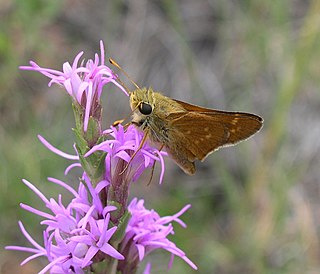
Hesperia leonardus, the Leonard's skipper, is a butterfly of the family Hesperiidae. There are three subspecies. Next to the nominate species, these are the Pawnee skipper, which is found in North America from western Montana and south-eastern Saskatchewan east to Minnesota, south to central Colorado and Kansas. Leonard's skipper ranges from Nova Scotia and Maine west through southern Ontario and the Great Lakes region to Minnesota, south to North Carolina, Louisiana and Missouri and the Pawnee montane skipper is endemic to the South Platte River drainage of Colorado.
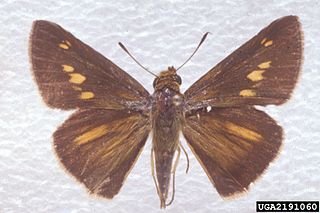
Euphyes dion, the Dion skipper or Alabama skipper, is a species of butterfly of the family Hesperiidae. It is found in scattered populations along the Atlantic coast of North America, from western Massachusetts and south-eastern New York south to north-eastern Florida, west to north-eastern Texas, and north to south-eastern North Dakota, northern Wisconsin, southern Ontario and southern Quebec. It is listed as a species of special concern in the US state of Connecticut.

Euphyes vestris, the dun skipper, sedge witch or dun sedge skipper, is a species of butterfly of the family Hesperiidae. It is found in North America from Nova Scotia west across southern Canada to southern Alberta, south to Florida, the Gulf Coast and eastern Texas. There are disjunct populations in the High Plains and Rocky Mountains and along the Pacific Coast.
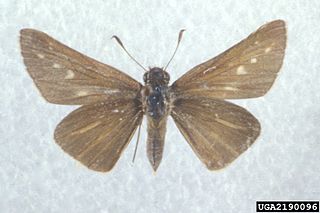
Panoquina panoquin, the salt marsh skipper, is a butterfly of the family Hesperiidae. It is found along the Atlantic Coast of the United States, from New York south to Florida and the Florida Keys, west along the Gulf Coast to southern Texas.

















